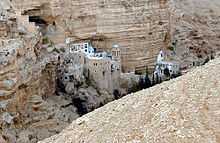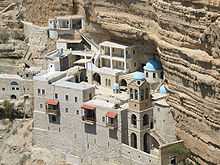St. George's Monastery, Wadi Qelt

Coordinates: 31°50′40″N 35°24′51″E / 31.8445°N 35.4141°E
St. George Orthodox Monastery, or Monastery of St. George of Koziba is a monastery located in Wadi Qelt, in the eastern West Bank. The sixth-century cliff-hanging complex, with its ancient chapel and gardens, is active and inhabited by Greek Orthodox monks. It is reached by a pedestrian bridge across the Wadi Qelt, which many imagine to be Psalm 23's Valley of the Shadow.[1] The valley parallels the old Roman road to Jericho, the backdrop for the parable of the Good Samaritan (Luke 10:29-37). The monastery is open to pilgrims and visitors.[2]
History

St. George's Monastery began in the fourth century with a few monks who sought the desert experiences of the prophets, and settled around a cave where they believed Elijah was fed by ravens (1 Kings 17:5-6).
This Greek Orthodox monastery was built in the late 5th century A.D. by John of Thebes. He became a hermit and moved from Egypt to Syria Palaestina in 480 A.D. The monastery was named St. George after the most famous monk who lived at the site – Gorgias of Coziba. Destroyed in 614 A.D. by the Persians, the monastery was more or less abandoned after the Persians swept through the valley and massacred the fourteen monks who dwelt there. The Crusaders made some attempts at restoration in 1179. However, it fell into disuse after their expulsion. In 1878, a Greek monk, Kalinikos, settled here and restored the monastery, finishing it in 1901. The traditions attached to the monastery include a visit by Elijah en route to the Sinai Peninsula, and St. Joachim, whose wife Anne was infertile, weeping here when an angel announced to him the news of Mary's conception. The bones and skulls of the martyred monks killed by the Persians in 614 A.D. can still be seen today in the monastery chapel.
References
- ↑
- ↑ Israel handbook: with the Palestinian Authority areas - Page 271 Dave Winter - 1999 "St George's Monastery Clinging to the side of the Wadi Qelt ravine, this monastery takes its name from St George of Koziba; a monk born in Cyprus c 550, but who spent much of his life at various lauras in the Judean Desert "
| Wikimedia Commons has media related to St. George's Monastery. |